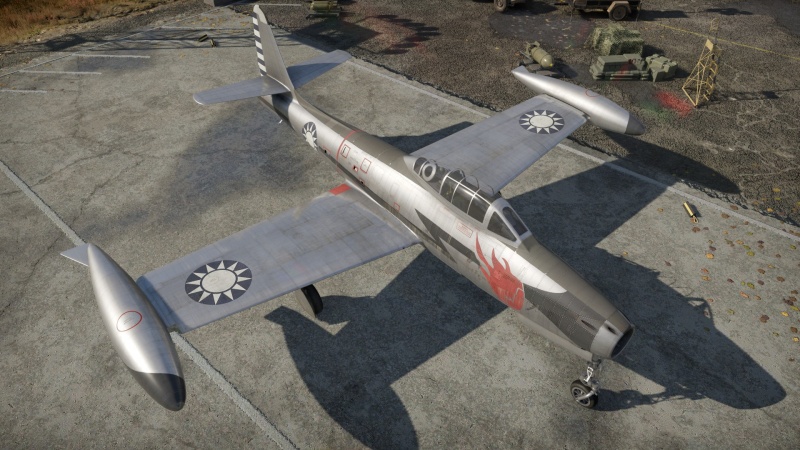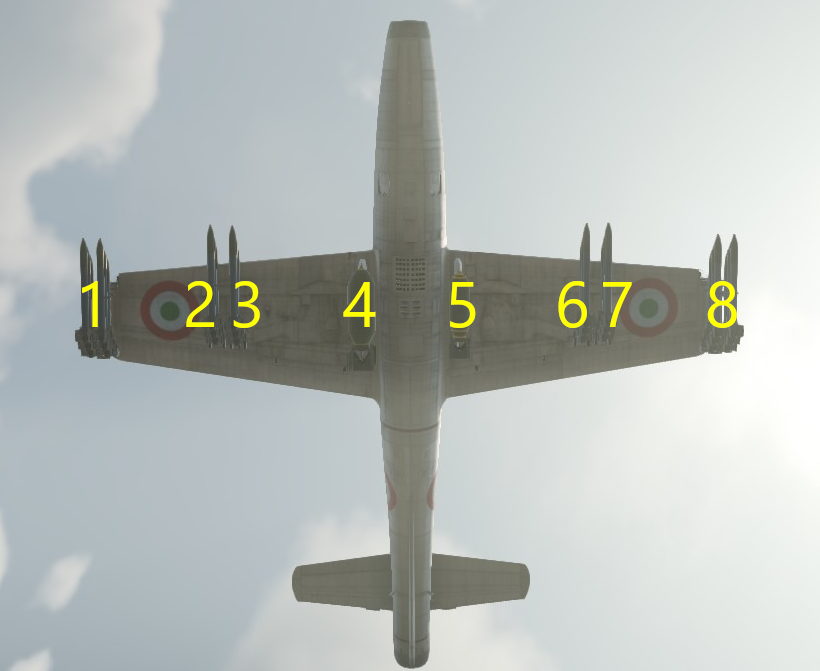F-84G-21-RE (China)
| This page is about the strike aircraft F-84G-21-RE (China). For other versions, see F-84 (Family). |
Contents
Description
The ␗F-84G-21-RE Thunderjet is a rank Chinese strike aircraft with a battle rating of (AB), (RB), and (SB). It was introduced in Update 1.91 "Night Vision".
Republic Aircraft Company's jump into the jet fighter market was not as smooth as they would have liked. They experienced severe growing pains as they developed and produced the F-84 series aircraft, especially the B, C, D and E variants. Important upgrades and modifications included a more powerful turbine engine, strengthened wings, aerodynamically secure wing-tip fuel tanks and a strengthened structure. The resultant of these upgrades was the much improved F-84G fighter, which boasted new innovations such as improved avionics, radar, the capability of in-flight refuelling and ability to carry a Mark 7 nuclear bomb. Though the operationally longest lasting of the series with the United States (into the mid-1960s), several other nations continued to use it including France and Italy, however, Greece continued flying their fighters until 1991.[1]
Even with the changes from earlier models, even in-game pilots will notice the quirkiness of the F-84G. Noted for its nickname "Lead Sled", the F-84G, like the B version in-game has an extremely long takeoff roll, around 1,500 m, typically due to the heavier payloads afforded to this aircraft. Though, once at altitude and during attack runs, the F-84G is an incredibly stable platform and can be outfitted with a number of various suspended armaments along with its six 12.7 mm M3 Browning machine guns. Each gun only has 300 rounds of ammunition, therefore trigger control is necessary or else the pilot will be left with empty guns in short order. Considered a multi-role aircraft, the F-84G can be utilised as a fighter-interceptor, bomber interceptor and ground attack fighter. The F-84G can be laden with a variety of bombs ranging from 100 lbs all the way up to two 1,000 lb bombs. HVAR and Tiny Tim rockets are a viable option alone or mixed with bombs to expand the options of targets to be attacked depending on the map the pilot is flying in.
Like many jet fighters, flying slowly makes for an easy target and this is no exception for the F-84G. Speed is necessary to ensure manoeuvrability both to engage a target and to shake a tail. Though not the fastest fighter at this rank, the F-84G can hold its own and when pressed, the six centre lined M3 Browning machine guns can punch enough holes in an enemy fighter to bring it down. Don't expect this fighter when laden down with two 1,000 lbs bombs or two Tiny Tim and 24 HVAR rockets to excel in a dogfight as it won't with all that weight, however, after all that ordnance is released the F-84B can then mix it up, though it is preferable to maintain speed while performing Boom & Zoom manoeuvres.
While dealing with mixed reviews over its positive and negative aspects, the F-84 series aircraft paved the way for a later aircraft which magnified all of the positive qualities of the F-84, being a stable firing platform, loaded to the gills with assorted suspended armaments and a main gun which rained destruction on the enemy, this aircraft would later be known as the Fairchild-Republic A-10 Thunderbolt II.
General info
Flight performance
The F-84G is a streamline all-metal jet fighter which was designed to house the upgraded Allison J35-A-29 turbine jet engine. Though an upgraded engine compared to the F-84B, typically this fighter was laden with more ordnance thus still requiring a significant roll-out time of 1,040 m (~3,400 ft) before lift-off. Don't be dismayed as other fighters are taking to the sky while you are still building up speed as once in the air you can climb to bomber altitude or set up for a ground attack run that few others can rival.
Though the take-off and climb characteristics of the Allison jet engine appeared lacklustre, it actually had decent level flight speed and good dive characteristics. Speed is what saves this fighter, in once it has enough built up, it will perform. Though not the fastest at its battle rating, the F-84G is a great boom & zoom aircraft vs. being a dogfighter. Turning this aircraft will bleed its speed and the roll rate can be affected by the weight of the wing-tip fuel tanks. One negative aspect of the wing-tip fuel tanks of the early F-84s was that high speeds (>1,000 km/h) tended to cause the fuel tanks to twist resulting (mitigated by the addition of fins on the tanks) in the destruction of the wings which does reflect in realistic and simulator battles in-game if exceeded. While turning in this jet is not advised, Immelmann and Split-S manoeuvres will help to conserve energy without compromising the speed of the aircraft.
If ever in danger of risking going faster than maximum rip speed, it is important to throttle back and extend air-brakes to reduce speed enough to keep the aircraft intact and manoeuvre in for the kill.
| Characteristics | Max Speed (km/h at 0 m - sea level) |
Max altitude (metres) |
Turn time (seconds) |
Rate of climb (metres/second) |
Take-off run (metres) | |||
|---|---|---|---|---|---|---|---|---|
| AB | RB | AB | RB | AB | RB | |||
| Stock | 976 | 971 | 29.0 | 30.4 | 30.8 | 29.3 | 3,000 | |
| Upgraded | 993 | 985 | 27.2 | 28.0 | 42.1 | 36.2 | ||
Details
| Features | |||||
|---|---|---|---|---|---|
| Combat flaps | Take-off flaps | Landing flaps | Air brakes | Arrestor gear | Drogue chute |
| ✓ | ✓ | ✓ | ✓ | X | X |
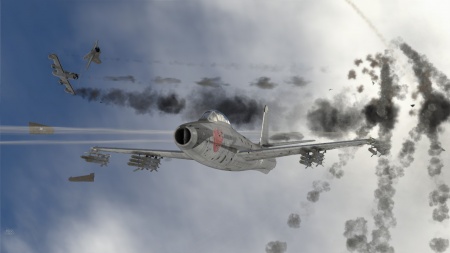
| Limits | ||||||
|---|---|---|---|---|---|---|
| Wings (km/h) | Gear (km/h) | Flaps (km/h) | Max Static G | |||
| Combat | Take-off | Landing | + | - | ||
| 527 | 499 | 350 | ~11 | ~5 | ||
| Optimal velocities (km/h) | |||
|---|---|---|---|
| Ailerons | Rudder | Elevators | Radiator |
| < 530 | < 600 | < 690 | N/A |
Engine performance
| Engine | Aircraft mass | |||||
|---|---|---|---|---|---|---|
| Engine name | Number | Empty mass | Wing loading (full fuel) | |||
| Allison J35-A-29 | 1 | 5,450 kg | 276 kg/m2 | |||
| Engine characteristics | Mass with fuel (no weapons load) | Max Takeoff Weight | ||||
| Weight (each) | Type | 8m fuel | 20m fuel | 27m fuel | ||
| 1,050 kg | Axial-flow turbojet | 5,868 kg | 6,447 kg | 6,685 kg | 9,979 kg | |
| Maximum engine thrust @ 0 m (RB / SB) | Thrust to weight ratio @ 0 m (100%) | |||||
| Condition | 100% | WEP | 8m fuel | 20m fuel | 27m fuel | MTOW |
| Stationary | 2,300 kgf | N/A | 0.39 | 0.36 | 0.34 | 0.23 |
| Optimal | 2,300 kgf (0 km/h) |
N/A | 0.39 | 0.36 | 0.34 | 0.23 |
Survivability and armour
- 38 mm Bulletproof glass in cockpit front.
- 6.35 mm Steel plate in front of pilot.
- 12.7 mm Steel plate in pilot's headrest.
- 8 mm Steel plate behind the pilot.
Like many early jet fighters, the armour was placed around the pilot while not much thought was given to the other critical components of the aircraft mostly due to the weight imposed on the early and weak turbojet engines placed into service. From behind, the pilot is protected by an 8 mm steel plate behind the seat with a 12.7 mm steel plate as a headrest. In front of the pilot, a 38 mm bulletproof windscreen adds protection from head-on's or from defensive bomber weapons. Another 6.35 mm steel plate is placed in front of the pilot and instrument panel for further protection of bullets entering the open-ended air-intake.
Other critical components such as the jet turbine, fuel tanks and coolers are all exposed, only protected by the outer skin of the aircraft which may deflect incoming bullets if at sufficient distance or angle to do so.
When attacking an F-84G, aim for the centre of the aircraft where you have a good chance of getting a critical hit on the engine or in a fuel tank. Due to this aircraft having wing-tip fuel tanks, shots to the wings or wing-tip tanks have a potential of starting a fire or breaking a wing off. If the attacking aircraft has sufficient calibre ammunition then shots taken at the pilot may have a larger chance of success if made from the sides or behind. This aircraft does not have much protection against rockets or missiles, however, given sufficient notice, rockets can be avoided and it is possible that missiles can be outmanoeuvred, however, when playing in realistic or simulator you run the risk of the pilot blacking-out due to G-force manoeuvres or wings snapping while trying to outfly a missile.
Modifications and economy
Armaments
Offensive armament
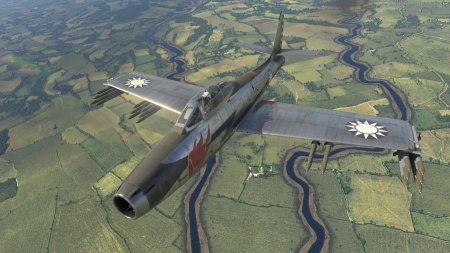
The F-84G-21-RE (China) is armed with:
- 4 x 12.7 mm M3 Browning machine gun, nose-mounted (300 rpg = 1,200 total)
- 2 x 12.7 mm M3 Browning machine gun, wing-mounted (300 rpg = 600 total)
Early fighters had many different configurations of machine guns and cannons mounted in the fuselage and in the wings, sometimes needing to be synced with the propeller to prevent its destruction. With the jet age developing, many factors of the past needed to be reconsidered with gun placement. With jet fighters flying faster and chasing faster targets, trying to find the sweet spot with gun convergence was extremely difficult, jet fighter pilots needed a little extra help with this. Besides implementing newer gun sights and early radar, jet fighter guns tended to be fuselage-mounted, thus eliminating the need to set the convergence and at any point between 0 and 800 m the ammunition rounds would fly true without a convergence point.
For the F-84G, four of the 12.7 mm M3 Browning machine guns were mounted in the fuselage with the other two mounted in the wing roots. While they were not all centre mounted, the two in the wing roots were close enough that convergence did not need to be messed with. Two ammunition options provide the most bang-for-the-buck, firstly, the omni-purpose rounds are good all-around ammunition rounds which provide tracers and explosive/incendiary rounds which are effective against aircraft and up to light armoured vehicles. Hardened vehicles and bunkers should be left to bombs and rockets for their destruction. If as a pilot you are looking for the sneak attack, stealth rounds will allow you to get on target fire off rounds and not give away your position, giving you a few seconds to make a second attack if needed before the target realizes where you are coming from.
Suspended armament
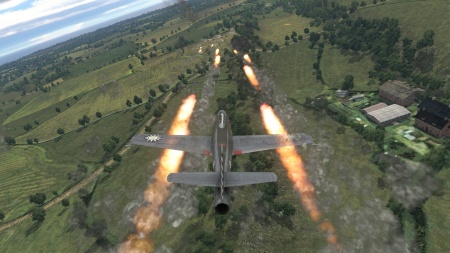
The F-84G-21-RE (China) can be outfitted with the following ordnance:
- Without load
- 12 x HVAR rockets
- 32 x HVAR rockets
- 2 x Tiny Tim rockets
- 2 x 100 lb AN-M30A1 bombs (200 lb total)
- 2 x 250 lb AN-M57 bombs (500 lb total)
- 2 x 500 lb AN-M64A1 bombs (1,000 lb total)
- 2 x 500 lb AN-M64A1 bombs + 24 x HVAR rockets (1,000 lb total)
- 2 x 1,000 lb AN-M65A1 bombs (2,000 lb total)
Custom loadout options
| 1 | 2 | 3 | 4 | 5 | 6 | 7 | 8 | ||
|---|---|---|---|---|---|---|---|---|---|
| 100 lb AN-M30A1 bombs | 1 | 1 | |||||||
| 250 lb AN-M57 bombs | 1 | 1 | |||||||
| 500 lb AN-M64A1 bombs | 1 | 1 | |||||||
| 1,000 lb AN-M65A1 bombs | 1 | 1 | |||||||
| HVAR rockets | 6* | 3 | 3 | 4 | 4 | 3 | 3 | 6* | |
| Tiny Tim rockets | 1 | 1 | |||||||
| Maximum permissible weight imbalance: 900 kg | |||||||||
| * HVAR rockets on hardpoints 1/8 may only be equipped simultaneously | |||||||||
The F-84G offers a range of bombs and rockets for destroying surface targets. Due to the more effective engine utilised in the F-84G, it could sport a larger number of suspended armaments compared to its older brother the F-84B, turning into a truly ground attack workhorse. In comparison, a fully-loaded single-seat F-84G-21-RE (China) had approximately the same loadout capability as an early 7 crew B-25J bomber. The smaller bombs such as the AN-M30A1 and AN-M57 and HVAR rockets are useful against soft targets like anti-aircraft batteries, unarmoured vehicles, ships and some light tanks. The heavier hitters like the AN-M61A1, AN-M65A1 and Tiny Tim rockets are effective (more like overkill) for the softer targets, but also work well with bunkers, heavier armoured tanks, larger ships and can also be utilised against bases.
Sometimes the suspended weapons you start out with doesn't work well later on in the match, therefore you can return to your base and exit the aircraft (default key = 'j') and select a different load-out unless you would like to fly strictly as a fighter where you can select "without load" and rely just on the six Browning M3 machine guns. The wide variety of ordnance options available for this aircraft make it an excellent clean-up ground attacker which can attack just about anything on the map with the right setup.
Usage in battles
The F-84G is a versatile multi-role fighter and can be configured to be used in various types of aerial warfare, namely bomber interceptor, ground attack and fighter-interceptor.
- Bomber Interceptor
Thanks to an upgraded engine compared to the F-84B, the G model has a bit more climbing power and does not need to rely solely on side climbing and reach the necessary altitude to begin hunting bombers or diving onto hapless fighters. As a bomber interceptor, the pilot has two options for weapon load-outs besides the default guns, noting the HVAR and Tiny Tim rockets.
If the F-84G is still stock or in the process of upgrading modules, the best bet will be to not load any suspended armaments and rely on the six 12.7 mm M3 Browning machine guns to do the work. Just using the machine guns will help save on weight and make it a bit easier to climb on the unmodified engine. For those pilots who have modified engines, they can opt for guns only for a quicker climb or attach HVAR rockets for an additional punch against larger bombers.
Once at altitude, scan and select a bomber target of opportunity. It is best to attain higher altitude than the bomber, giving you options as to which direction to attack from and increase your speed when diving in, speed is key to avoid defensive guns, race out of their range and to gain enough distance to safely turn around and follow up with another attack if needed.
Since the six M3 machine guns are virtually centred on the aircraft, the inbound bullets will be clustered and should be aimed at engines, cockpit, fuel tanks and any other critical areas as the body of the aircraft can sometimes absorb a large amount of smaller calibre ammunition before causing a critical hit or crippling the aircraft. The limitation of only 300 rounds per gun will require trigger discipline by the pilot to ensure enough rounds are available for a secondary or tertiary attack without having to reload or return to base.
Utilizing HVAR rockets at large lumbering bombers can have a great impact, though unguided, they will need to be pointed in the general direction when launched, it may take several practice runs to determine best angle and distance in which to fire from for a successful attack. As with any unguided rocket, the best bet is to launch a volley of rockets to ensure a greater chance of at least one hitting.
- Ground Attack
Jet fighters tend to not make good ground attackers as it typically requires them to fly low and slow making them easy pickings for enemy fighters above or anti-aircraft fire below. Since the F-84G is neither an exceptionally fast fighter nor a lumbering bomber, it has an advantage of being fast enough to be dangerous to ground targets without being a sitting duck for patrolling enemy fighters. Compared to many other fighters which are capable of ground attack, the F-84G can carry a fantastic amount of ground attack ordnance which can seriously put a dent into the enemy teams vehicles, bunkers and bases.
While many aircraft available in War Thunder has a specific role of fighter-interceptor, ground attack or bomber, the F-84G can set itself up with suspended ordnance depending on the targets available on the map. The F-84G has several options depending on the modules unlocked by the pilot which range from outfitting HVAR unguided rockets, massive Tiny Tim unguided rockets, 100 lb, 250 lb, 500 lb and 1,000 lb bombs or a mixture of bombs and rockets.
Smaller bombs and the HVAR rockets are best for going after lighter armoured targets such as aircraft (on the ground or with rockets in the air), anti-aircraft batteries, trucks, some light tanks and ships. The larger Tiny Tim rockets and bombs are best reserved for more hardened targets like pillboxes, medium and large tanks, bunkers, large ships and bases. This fighter is not afraid to get down and dirty taking out ground targets, just be aware of your surroundings and watch for enemy fighters or anti-aircraft guns poised to take you out.
- Fighter Interceptor
While definitely not the fastest nor the most manoeuvrable fighter on the field, the F-84G has enough speed and manoeuvrability to take on fighter jets. The centerline six M3 machine guns concentrate enough lead into one spot to damage or destroy fighter aircraft flying in its path. While turning this fighter is bad due to bleeding airspeed (although maybe an option if you are trying to force an overshoot), Immelmann and Split-S manoeuvres will help you change directions keeping up your speed and allowing for a getaway or a targeting solution.
Boom & Zoom tactics will enable the F-84G to have the speed to manoeuvre and set up their shots and keep them active in the fight. Many enemy fighters may mistake the F-84G as a weak and slow aircraft, however, the machine is not 100% of the solution and many pilots can take lesser aircraft and best faster, more agile and better-gunned aircraft by using their training, skills and the F-84B. The only time to count out the F-84G is when you see the pilot bail out, otherwise, always consider it a threat.
Radars
The F-84G is equipped with an AN/APG-30 rangefinding radar, located in the nose of the aircraft. It will automatically detect other planes within the scanning area and display the range to the closest target. It is linked with a gyro gunsight and can help with aiming at close range.
| AN/APG-30 - Rangefinding radar | |||
|---|---|---|---|
| Maximum Tracking Range |
Minimum Tracking Range |
Azimuth Tracking Angle |
Elevation Tracking Angle |
| 2,750 m | 300 m | ±9° | ±9° |
Pros and cons
Pros:
- Center-line armament of six .50 cal machine guns with a great rate of fire
- Huge payload options, a fantastic ground attacker
- Good acceleration
- Excellent dive speed
- Sturdy wings, nearly unrippable
Cons:
- Turn rate is not very good, though better than the F-84B
- Manoeuvrability diminished with heavy payloads
- Middle road fighter, not the best or fastest, but capable
- Long takeoff roll out
History
See also: F-84G-21RE
As part of the MAP for US-allied countries/regions, ROCAF received their first jet- F-84G series in 1953 (ROC Year 42) and before fleets of F-86s and F-104 series entered service by late 1950s. F-84Gs have been the cornerstone of ROCAF and one of the participants of the Taiwan Strait Crisis where the jet have scores over 2 MiG-17s of PLAAF on 1956/7/21 by Heinz Ouyan (歐陽漪棻; Ouyang Yifeng in Pinyin, 1929/8/3-2020/5/5; Sino-German mixed race) and left the only remarkable victories of F-84 series over Soviet built jets.
As more advanced jets joined ROCAF rapidly by later-1950s, the remaining combat variants of F-84Gs were decommissioned by 1960 and some of these jets are now displayed at some locations throughout Taiwan Island.
Media
- Skins
See also
- Other versions
- Contemporary aircraft
- de Havilland Venom
- Gloster Meteor
- Dassault M.D.450B Ouragan
- Grumman F9F Panther (USAF)
- Grumman F9F Cougar (US Navy)
External links
References
- ↑ Burrows, W. E. (2013, August). It had the body of a fighter and a bomber's soul. Retrieved from https://www.airspacemag.com/military-aviation/thunderjet-307269/
| Republic Aviation Corporation | |
|---|---|
| Fighters | P-43A-1 |
| P-47D-22-RE · P-47D-25 · P-47D-28 · P-47M-1-RE · ⋠P-47M-1-RE · P-47N-15 | |
| Jet Aircraft | F-84B-26 · F-84F · F-84G-21-RE |
| F-105D | |
| Export | J9 Early* |
| ␗P-43A-1 | |
| ▄Thunderbolt Mk.1 · ▄P-47D-22-RE · ␗P-47D-23-RA · ▂P-47D-27 · ␗P-47D-30 · ▄P-47D-30 · ␗F-47N-25-RE | |
| ◄F-84F · ▄F-84F (Italy) · ▄F-84F (France) · F-84F IAF · F-84F | |
| ␗F-84G-21-RE · ▄F-84G-21-RE · ▄F-84G-26-RE · ␗F-84G-31-RE | |
| Captured | ▀P-47D-16-RE · ▀P-47D |
| *The company was named "Seversky Aircraft Company" before being renamed in 1939 | |
| China jet aircraft | |
|---|---|
| Fighters | J-2 · J-4 · J-6A · J-7II · J-7D · J-7E · J-8B · J-8F · J-10A · J-11 · J-11A |
| Strike aircraft | Q-5 early · Q-5A · Q-5L · JH-7A |
| Bombers | H-5 |
| France | ␗Mirage 2000-5Ei |
| USA | ␗F-84G-21-RE · ␗F-84G-31-RE · ␗F-86F-30 · ␗F-86F-40 · ␗F-100A · ␗F-100F · ␗F-104A · ␗F-104G · ␗F-5A · ␗F-5E · ␗F-16A MLU |
| USSR | ␗MiG-9 · ␗MiG-9 (l) |
| North Korea | Shenyang F-5 |
| Pakistan | A-5C · JF-17 |



